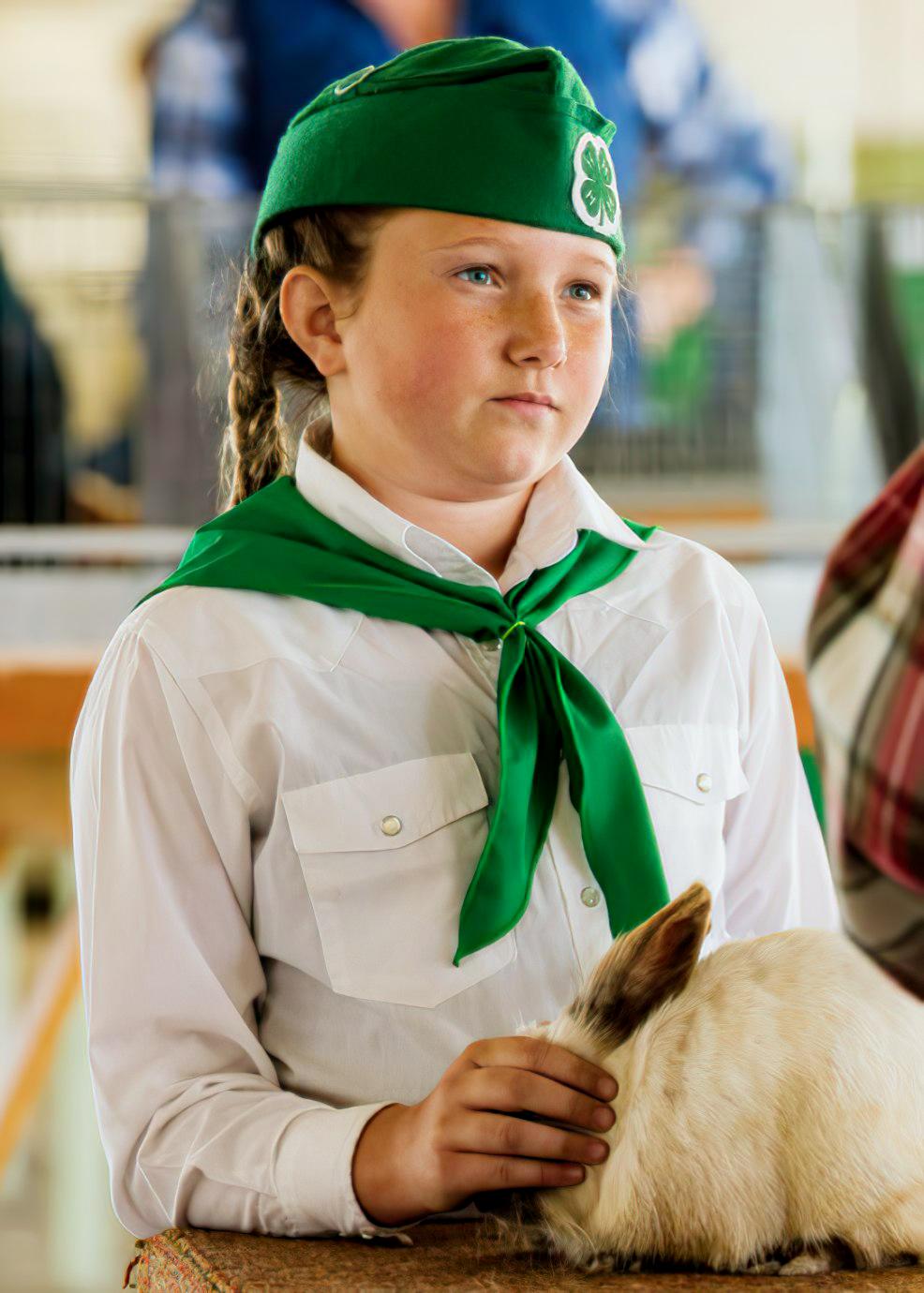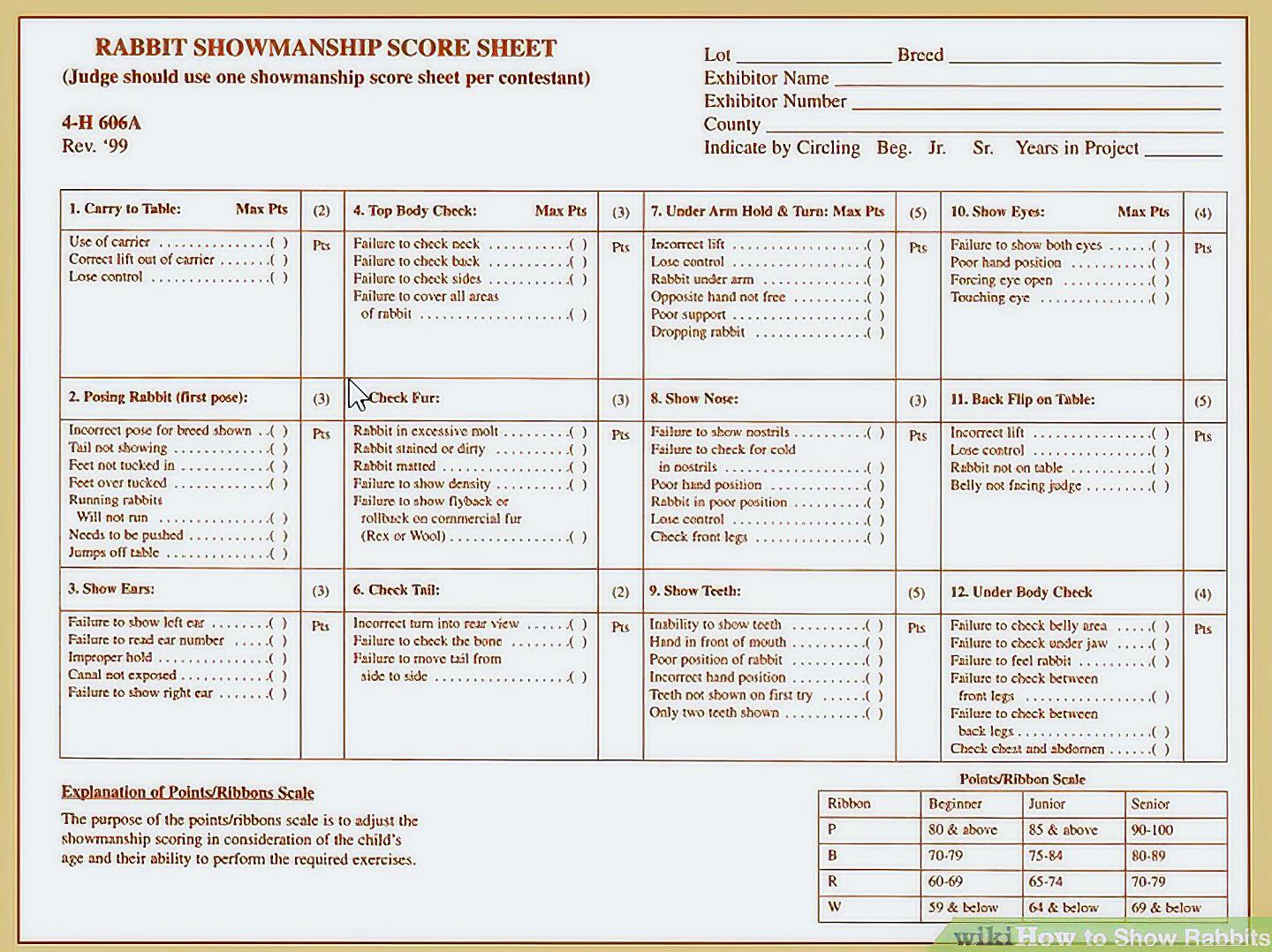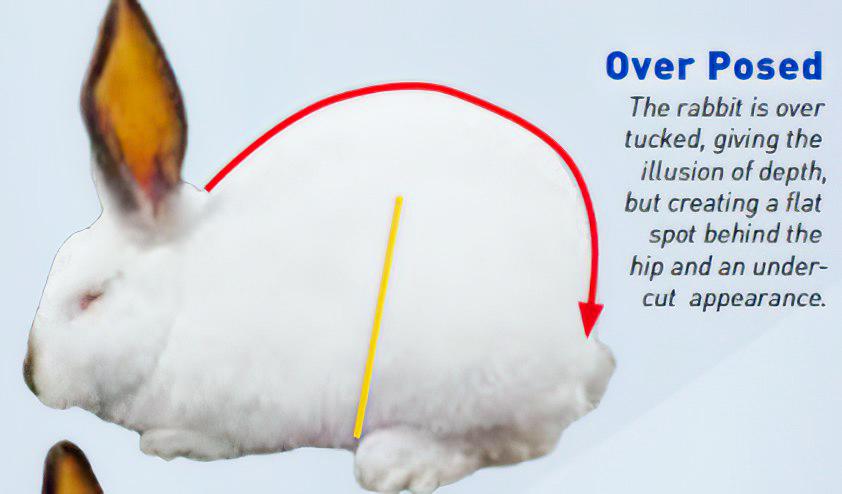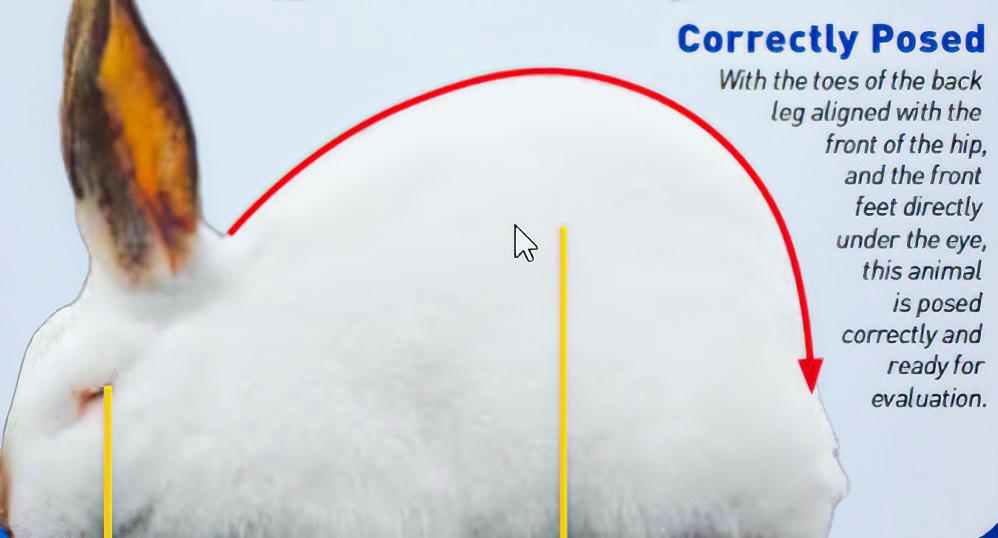How to raise rabbits for shows including pre-show preparation and diet and health tips.
Raising rabbits for show requires careful preparation and research starting by selecting the right rabbit breed (with the easiest temperament) and making sure you have the most appropriate equipment from cages, nest boxes and grooming tools. You should have some experience in raising rabbits from birth including knowing about the best diets and housing requirements for your show rabbits.
Many rabbit breeders who participate successfully in rabbit shows started out as rabbit pet owners who enjoyed raising rabbits and wanted to celebrate their efforts (and their rabbits) to a wider audience.
The American Rabbit Breeders Association (ARBA) now recognizes 50 different domestic rabbit breeds as suitable for showing. If you are a beginner to showing rabbits, we recommend you start by selecting some of the dwarf and smaller-sized breeds with the calmest temperaments. These include: the Dutch, the Mini Rex, Holland Lop, Polish or the Lionhead.
This article will walk you through all the necessary steps to get your rabbits show-ready.
Getting started – essential equipment
Before entering a show you want to make sure that you have one or more purebred rabbits which are of a breed recognized by the American Rabbit Breeders Association (ARBA). You need an accredited breed to be allowed to show your rabbits at ARBA shows as well as your local county or state fairs. To get up to speed on showing rabbits it’s well worth your time networking with other rabbit breeders to not only find the right breed to show but also to learn about best practices (including proper showing techniques and safe handling) when showing rabbits.
After you have chosen which rabbit breed you want to specialize in showing, you should approach an accredited rabbit breeder to find a pair of rabbits to start your bloodline. Show rabbits purchased from a breeder can cost from between $20 and $50 or even more (depending on the breed and pedigree).
It’s always best practice to find your rabbit pair from an accredited breeder. It’s also very useful to start networking with professional rabbit breeders before starting to show rabbits as you can pick up a lot of insider industry knowledge to help you succeed.
In terms of equipment you need, start by deciding how many rabbits you intend to breed and sourcing the best starter stock. You will initially need about 15 or 20 “holes” or cages to house your animals. Allowing yourself 15 cages allows you to house your new rabbit arrivals and to improve the bloodline.
When you first start to enter the rabbit show circuit, don’t overextend yourself by attempting to breed more than 15 rabbits to begin with. Start small and focus on excellence in a limited breeding program. It’s also better to have less rabbits which are healthier and better socialized (because of frequent handling) than to have too many rabbits which are skittish because you haven’t had time to properly prep and train them for shows.
You should choose all-wire cages rather than solid-bottom rabbit cages or hutches as solid bottomed cages can have a buildup of urine soaking the floors (even with the best intentioned and fastidious rabbit breeder regularly cleaning the hutch). Urine-soaked rabbit cage floors are both unhygienic for your rabbits and they can result in your show rabbits having urine stained fur prior to the show. All-wire cages also keep your rabbit’s personal space cleaner and reduce the ammonia smell from rabbit urine.
Diet and Grooming
Your show rabbits should have the best possible diet. This starts by making sure your rabbits always have a plentiful supply of fresh, clean water to keep your rabbit’s digestive system sufficiently lubricated and working efficiently. A well-hydrated rabbit also looks healthier and performs better in shows. Regardless of whether you choose a large ceramic water bowl or bottle tube waterer, ensure that your rabbit’s dispenser is kept clean and replenished every day.
An ideal diet for most rabbit breeds includes timothy hay or oxbow hay, pellets, and lots of fresh vegetables. Rabbits love to eat celery, carrot tops and collard greens. Your rabbit should be eating around one ounce per pound of their body weight per day. You should ensure there is always lots of fresh hay which is replenished daily. The fiber in the hay is great for their digestive systems and it also keeps their teeth filed down (to prevent malocclusion issues).
Your rabbit grooming equipment should include a basic grooming kit which you can take to the rabbit shows. A good show grooming kit would have a brush, scissors, pet nail clippers and wet wipes. Now that you have assembled all your equipment and your breeding stock, your next move is to find the closest rabbit show. This is where the fun begins.
Registering for a Rabbit Show
The United States has many different organizations which host and hold rabbit shows. Your first port of call is the American Rabbit Breeders Association (ARBA) but you can also show with 4-H or Future Farmers of America (FFA).
4-H refers to American based youth organizations which are designed to teach young people life skills focusing on “head, heart, hands and health”. 4-H organizations are administered by the National Institute of Food and Agriculture of the United States Department of Agriculture (USDA).
Rabbits shown in the 4-H category must be four years old or more. If you are entering your rabbit into 4-H categories you can also focus on rabbit showmanship which is where you show the judging panel how well your rabbit conforms to breed standards as well as your own general knowledge about rabbits.

Rabbit shows hosted by 4-H or FFA are usually held at state or district fairs. The ARBA organizes larger rabbit shows all across the United States. You can start by a simple Google search “rabbit shows near me” to see which is the best one for you to enter. The ARBA also has a full list of shows on their site which is updated weekly.
Once you find the rabbit show that is most convenient to your location, it is recommended that you request a show catalog from the Show’s Secretary. The show catalog will give you detailed instructions about how and when to enter your rabbit. After the Show’s Secretary emails or sends you the catalog, make sure you complete your entry correctly and submit it by the show’s deadline. Your rabbit will be judged on how well it conforms to the written Standard of Perfection for your particular breed.
You will be required to enter your rabbit in the correct class for its age, weight and breed. You must enter your rabbit in the correct category or risk being disqualified on the day – so read the paperwork and double-check your completed entry before submitting to the show’s organizers. Make sure you have paid your entry fee by the due date as well as meeting any other mandatory requirements prior to the show.
After you have done this, take some time to review the show’s judging protocols and procedures. This should tell how each entrant is judged. Generally speaking, rabbit shows judge each rabbit’s weight, fur quality, appearance of their tails, ears, eye colors and overall health and demeanor.
They should also have advice on how each breed is required to be “posed” on the judging table. Learning how to correctly handle and pose your rabbits is an important skill which will determine how successful you will be in showing your rabbit.
Preparing your Rabbits for Show
Before attending the rabbit show, it’s a good idea to have an idea of what specifics the show will be judging each rabbit breed on. Your show should have a “Rabbit Showmanship Score Sheet” (see example image below) which shows how points are awarded during each stage of the show.

The judging criteria also looks closely at how you handle and pose your rabbit which we discuss in more detail below.
Conditioning your rabbits for show
After you have identified which rabbit shows you are going to attend you can take some simple steps in advance of the show to prepare your rabbit. You need to focus on ensuring your rabbit is at optimal health and is trained to pose for the judges and is accustomed to being handled by yourself and others. Your preparation can start weeks or even months before you attend the show.
Begin with a supplemental conditioner at least three months before the show date. A supplemental conditioner is a dietary supplement which will optimize your rabbit’s health and fur appearance before a show. You can purchase a commercial conditioner or make your own. A homemade rabbit conditioner would include oatmeal or barley, wheat germ, or black oil with a pinch of salt or molasses – which you sprinkle on top of your rabbit’s normal food supply.
If you buy a commercial conditioner, follow the instructions about how much to feed your rabbit and how often. Good commercial conditioners are Doc’s Rabbit Enhancer, Calf-Manna or ShowBloom – all easily added to your rabbit’s food bowl.
Rabbit handling techniques to make your rabbit show-ready
Rabbits who perform well at rabbit shows are accustomed to being handled by their owners and other people. Rabbits who are comfortable at being handled are generally more tame and socialized. They are also more likely to remain still during the judging process.
You can easily familiarize your rabbit to being handled by both yourself and other people. You start by cradling your rabbit in one arm and gently touch its ears, feet and around the eye area. This will make your rabbit feel comfortable and safe. You might also want to engage a friend to hold and pat your rabbit while speaking softly to it. This teaches the rabbit that it is safe even when handled by strangers or people other than their owners. This will prepare your rabbit for the judge’s inspection (and handling) on show day.
There are also some basic do’s and don’ts around safe handling of rabbits including:
- Wear long sleeves to protect your arms from getting scratched.
- Handle your rabbit gently and carefully. Avoid startling your rabbit. Lots of gentle handling will socialize your rabbit.
- Never lift a rabbit by its ears which is painful and can damage its delicate ear tissue. A rabbit picked up by the ears will startle and this is where they can very easily fracture their backs or hind legs as they struggle to escape.
- Never lift a rabbit by the scruff of its neck without supporting the entire body. This can also damage their fur.
- To get your rabbit used to a judging table, place the rabbit on a table covered in carpet or fabric so they can get a foothold. Smooth surfaces and shiny tables can make your rabbit slide around and they will feel insecure and may startle.
- Handle your rabbit in the coolest part of the day and across two or three brief sessions during the day rather than one long session.
- When carrying your rabbit, always tuck its head under your arm while you support its body between your side and your arm. You can cover the rabbit’s eyes with your elbow. Support their hindquarters with your other arm. This will make your rabbit feel secure.
Rabbits are excitable and nervous by nature and gentle handling is important to develop trust between you and your rabbit in the weeks before attending the rabbit show.
Grooming your rabbits for show
You should be getting your rabbit accustomed to grooming at least six weeks before any rabbit shows. Daily grooming is important and it improves the appearance of your bunnies as well as getting them used to frequent and gentle handling.
You can craft your own grooming stand using a table with a rug or fabric covering it. Start by grooming your rabbit in the coolest part of the day. Moisten your hands and rub them through the rabbit’s fur (from their heads to their tail) until their fur is damp. After dampening their fur, stroke your rabbit from head to tail multiple times which will remove dead fur particles. Avoid rubbing the fur backwards (or against its natural grain) as this can fracture the guard hairs.
Daily grooming in the manner recommended above will ensure that your rabbit is show-ready with healthy fur as well as becoming used to being handled regularly – resulting in a calmer, more docile rabbit. Next step is teaching your rabbit to pose correctly so you can showcase the best features of your rabbit for the judges.
The importance of posing your rabbit at the show
Correct posing of your rabbit is one of the most important skills you (and your rabbits) need to master in advance of any rabbit show. You need to be able to identify how to correctly pose a rabbit and the difference between an over-posed and an under-posed rabbit.
When you are posing a commercial type rabbit, you must first place their front feet directly beneath their eyes. You then need to align the toes of their rear feet with the front of their hips.
One of the easiest ways to fail during judging is by incorrect or inconsistent posing. Correct posing is how the judges can most accurately identify and comment upon your rabbit’s body type. The biggest mistakes that beginners make is in overposing. This can distort your rabbit’s appearance making them appear longer with narrow hindquarters. The image below is an example of what an over-posed rabbit might look like:

An under-posed rabbit will create the illusion that the animal has a larger hindquarters with more length but less depth.

The way you pose your rabbit also depends on the judging specifications for that particular breed. You should be able to get full details on the ARBA Standard of Perfection for each breed of rabbit to assist you in making the best impression at the rabbit shows.
Once you have learned the correct way to pose your rabbit, it is worth taking the time to practice posing your rabbit to prepare for the judging process. Many judges may even ask you to hold the rabbit in place in a particular pose during assessment. This is where practicing your rabbit’s pose at home beforehand and getting your rabbit accustomed to sitting still (in the presence of strangers) is excellent preparation.
For every type of rabbit breed, correct rabbit posing means that you align the tip of the rabbit’s front feet with its eyes. You also then align the tip of its hind feets with its hip bones and make sure the tail is visible. You then train your rabbit to stay in place and remain still. You can use bunny treats to hasten the training process. A correctly posed rabbit should mirror the image below:

At the rabbit show, when instructed by the judging panel, approach the judging table with your rabbit and place your rabbit on the table. If you are right handed, face your rabbit towards the right and if you are left handed, face your rabbit to the left – making it easier for you to handle your rabbit. Align the tip of your rabbit’s front feet with your rabbit’s eyes. Next position the tip of the rabbit’s hind feet so that they are aligned with the rabbit’s hip bones. Finally make sure your rabbit’s tail is visible and not tucked under its body.
Show day preparation
On the days leading up to the show make sure you have completed all the important pre-show health checks. Check that your rabbit doesn’t have any common illnesses like pinworms, a runny nose or ear mites.
On the night before the show make sure all your paperwork is in order. This includes writing down the ring or tattoo number for each rabbit you plan to show. The Show’s secretary will require all this paperwork before judging.
Prepare your rabbit carrying box with fresh bedding. Avoid using newspapers which can leave marks on a rabbit after they urinate in their boxes and lie on their bedding. Also don’t give your rabbits treats just before judging (like carrots, beetroot leaves and fresh grass) in case they soil their bedding or carrying box (and their fur). This will ensure your rabbit stays as clean as possible before judging.
Give your rabbits some hay or straw to nibble on prior to the show and to help them settle. Remember to take a grooming kit with you to the show to touch up your rabbit (which should include a comb, nail clippers, antibacterial wipes and paper towels).
Working with your rabbit on show day
On show day the things to focus on are safe transport to the show, paperwork in order, final health checks and grooming.
On show day complete any last-minute grooming on your rabbit. Make sure their toenails are neatly clipped and their fur is free of snaggles. Clean up any discharge with a moistened cloth around their eyes or any urine stains or fecal build-up near their rear end.
Brush your rabbit’s fur before the show to keep it looking neat. Long-haired rabbits required brushing every second day. Check the doe’s dewlap as this area can be overlooked and knotty and also the buck’s hind legs which can have a build-up of knotty fur. If you find a large knot, use your fingers to separate the fur and open the knots gently, then brush it out neatly.
After brushing your rabbit, rub your rabbit’s fur with a damp cloth to remove any dead fur particles. Note that there are some breeds which have rex fur (such as castor rabbits) which shouldn’t be brushed as this can damage their fur. You should be bringing your grooming kit to the show to complete any final touch-ups prior to judging.
On your way to the show, keep your rabbit comfortable and cool while you transport it. Make sure that your rabbit carrier has a little hay and a water bottle to keep your rabbit hydrated. Ensure that you transport your rabbit to the show in an air-conditioned vehicle in its show coop (which is a wire cage).
Give yourself plenty of time to arrive at the show – ideally arriving at least half an hour before judging is about to start. Find the numbered wire pen where your rabbit will be housed along with your booking-in card and other paperwork. Check with the Show’s Secretary if you have any other questions.
What judges look for at rabbit shows?
Judges at rabbit shows will focus on the following health and appearance issues:
- Ears – They will check for the presence of ear cankers (caused by ear mites). They will also read the tattoo number and verify how legible it is. Judges will consider the size and carriage of the ears and check for tears/injuries or the rabbit is missing any part of its ear.
- Eyes – They will look for wall eye (white cornea) also noting if there are any spots on eyes, mismatched eye color or runny or weepy eyes.
- Nose – They will check your rabbit’s respiratory health and check for colds indicated by presence of a white nasal discharge.
- Teeth – They will look for malocclusion as well as any broken or missing teeth.
- Chin and neck area – Judges will check the dewlap (in does) to see if there are abscesses caused by skin diseases.
- Front legs – They will assess to check for bent, bowed or deformed limbs.
- Hind legs – focusing on whether they are bent, bowed, deformed, or severely cow hocked.
- Hocks – Where they check for sore hocks.
- Hind feet and toenails – They check for missing toenails (there should be four on each hind foot); Broken toenails (or those which are too short to determine color); unmatched toenails or nail color not meeting standard.
- Front feet and toenails – checking for missing toenails (there should be five on each front foot) including the dewclaw. They also judge whether toenails are broken or too short to determine the breed’s color as well as unmatched toenails or the nail color failing to meet the breed standard.
- Abdomen – Judges will check for mastitis/swollen teats; tumors, rupture or hernia or abscesses.
- Sex – They check for vent disease; missing testicles on senior bucks, junior buck with only one testicle showing or split penis.
- Tail – To check for stub, broken or wry tail.
A calm, correctly posed rabbit has the best chance of scoring well at a rabbit show. Judging starts with ruling out any disqualifications and considering the quality of the class of rabbits competing. As well as the items listed above, judges will also weigh rabbits if they appear over or underweight for their breed category. You might also see judges doing quirky things like placing coins or chips in front of each rabbit to keep track of their observations.
Rabbit showmanship and etiquette
During judging, always be present. You should also follow expected rabbit show etiquette and this means not revealing which rabbit is yours to other spectators or the judge. The judges will identify the rabbits based on their ear tattoos. Your rabbit will be placed in a show coop while judging is taking place.
Rabbit showmanship is where you can demonstrate your skill in handling your rabbit and your knowledge about your rabbit’s breed, its particular qualities as well as it’s faults or possible disqualifications according to the breed standard. When displaying your rabbit, move slowly and deliberately (to avoid startling your rabbit), carry your rabbit appropriately with proper support and rest the rabbit’s weight on the table while you are turning it over for the judges to inspect.
Your level of professionalism is reflected in your ability to follow the judge’s instructions and be polite to other competitors while respecting the judge’s ruling. In terms of dress code, we recommend that you wear long sleeves while handling your rabbit and a show coat or a lab coat. Long pants and semi-formal clothing are recommended as well as closed toe shoes. You might also want to take notes or carry a clipboard to record your observations or keep judging and comment cards.
As soon as judging is completed, rabbits which aren’t placed in each class are removed from the staging area. Make sure that you take your rabbit off the table straight after judging. To avoid collecting another competitor’s rabbit by mistake, always check the ear tattoo before removing your rabbit from the judging table. The judges will read out the ear numbers of the rabbit which must be removed.
The top five rabbits will receive sweepstakes points based on their breed and one rabbit will be judged as best in show for their breed and class. You can win trophies, ribbons and other prizes at rabbit shows as well as getting sweepstakes points and grand championship leg certificates. If your rabbit does well in the show, this raises your profile amongst other breeders who might seek to purchase offspring from your award-winning rabbits.
When judging is completed, return your rabbit safely to its rabbit carrier to avoid stressing it. Reward your rabbit with treats (and kindness) for successfully competing in its first show.
Raising rabbits for show is a fun way to meet other rabbit enthusiasts while you learn a lot about best practices for raising, showing and caring for rabbits generally. The friendly competition and camaraderie you will experience at rabbit shows makes the whole process worthwhile and you will get to meet people from all walks of life along with their delightful rabbits.



Leave a Reply